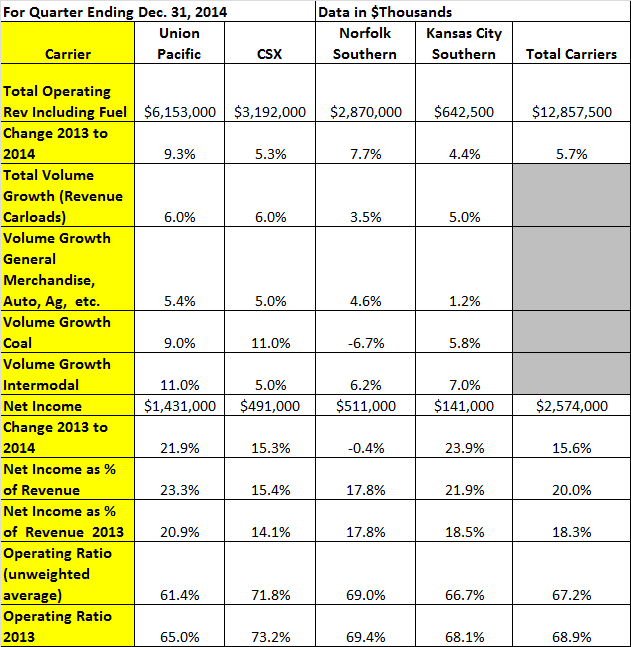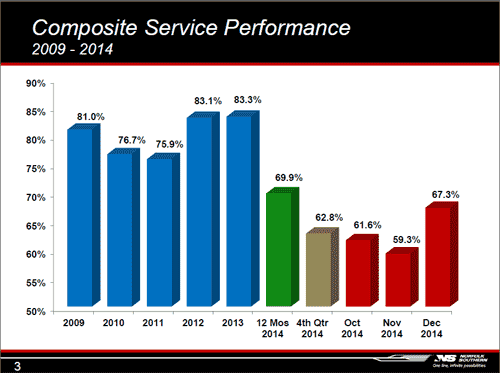From SCDigest's On-Target E-Magazine
- Feb. 3, 2015 -
Logistics News: US Rail Carriers Enjoy Generally Strong Q4, as Union Pacific Again Leads the Way
Record Low Operating Ratios Continue to be the Rule, as Union Pacific Sets New Target after Reaching Previous One in 2014
SCDigest Editorial Staff
US rail carriers enjoyed a generally strong quarter in Q4 for the third straight reporting period, with only Norfolk Southern left out of the profit party, while rail volumes were generally strong. That even as rail pricing power continues to wane.
SCDigest Says: |
 After now having achieved its target of a full year operating ratio of below 65% in 2014, UP has set a new full year target of 60% by 2019. After now having achieved its target of a full year operating ratio of below 65% in 2014, UP has set a new full year target of 60% by 2019. |
| |
|
What Do You Say?
|
|
|
|
We're back as usual every quarter with our review of the results and trends across freight modes, starting this week with US rail carriers, which all posted their results before the end of January.
We hope to cover the US truckload sector next week - if the reporting is complete - and then the LTL carriers the week after that.
Here we look at the four major Class I public carriers that make up the US rail sector (Burlington Northern is of course part of public company Berkshire Hathaway, but its results are not broken out in any detail and thus are not included)
Of course, the Q4 results also included full year 2014 numbers, so we will take a look at those as well.
For the year, the Association of American Railroads says total combined traffic for 2014 on U.S. railroads was 28,673,776 carloads, containers, and trailers, up 1,233,184 units or 4.5% over 2013 and the highest annual total since 2007. So macro-conditions were solid for rail carriers for most of the year.
Intermodal traffic, however, continued to outperform, with intermodal volumes setting a record with 13,496,941 containers and trailers in 2014, up 5.2% or 665,630 units over the previous record set in 2013, as intermodal continues to be the growth engine for both rail and the truckload sector.
As seen in the chart below, all the rail carriers but Norfolk Southern saw carload gains in the 5-6% range in Q4, pretty good growth all told. As seen further down the page, there were similar growth numbers in terms of carloads for the entire year.
Intermodal growth is generally faster than regular carloads, especially at Union Pacific, where 2014 intermodal volumes were up a very strong 11% year over year. US rail carriers also seem to have stopped the bleeding on coal volumes, with only Norfolk Southerm down in coal units for the year - a big change from the past few years when coal olumes were regularly falling by near or above double digits.
Profits were again strong as they were in Q2 and Q3, up 15.6% versus Q4 in 2013. Net income as a percent of revenue came in strong again at 20%, up a few ticks from Q3. It wasn't all that long time ago that railroads were a very challenged industry in terms of profits.
Union Pacific was able to achieve operating income as a percent of revenue of an impressive 23.3%, a number that would stand up very well against almost every sector. Procter & Gamble's net income as a percent of revenue in Q4 was 11.8%, for example.
The rail carriers also continue to drive down their operating ratios, or operating expense divided by operating revenue, a key metric in the transport sector. Here again Union Pacific led the way, pushing its OR down to a record 61.4% in Q4 and 63.5% for the full year. Only CSX had an OR of over 70% in Q4, with an unweighted average for the group of 67.2%, down from 68.9% in 2013.
All that even as pricing power by the rail carriers seems to have waned a bit in recent quarters. A few years ago, pricing gains in the 5% range were commonly cited. In 2013, that dropped to more like 4%. In Q4, while Union Pacific said it was able to achieve core pricing gains of 3%, the other carriers implied rates were even flatter than that - but that didn't stop the rail profit machine for the quarter.
Q4 2014 US Rail Carrier Results

Service issues continued to be a problem, as they have been all year, with train speeds slowing again and train dwells times not good in Q4 compared to recent years - and there was little bad weather to blame this time. The chart below shows the deteriorating service performance by Norfolk Southern in 2014 versus prior years.
Rail Service Deteriorated at Norkfolk Southern, Other Carriers, in 2014

(Transportation Management Article Continued Below)
|